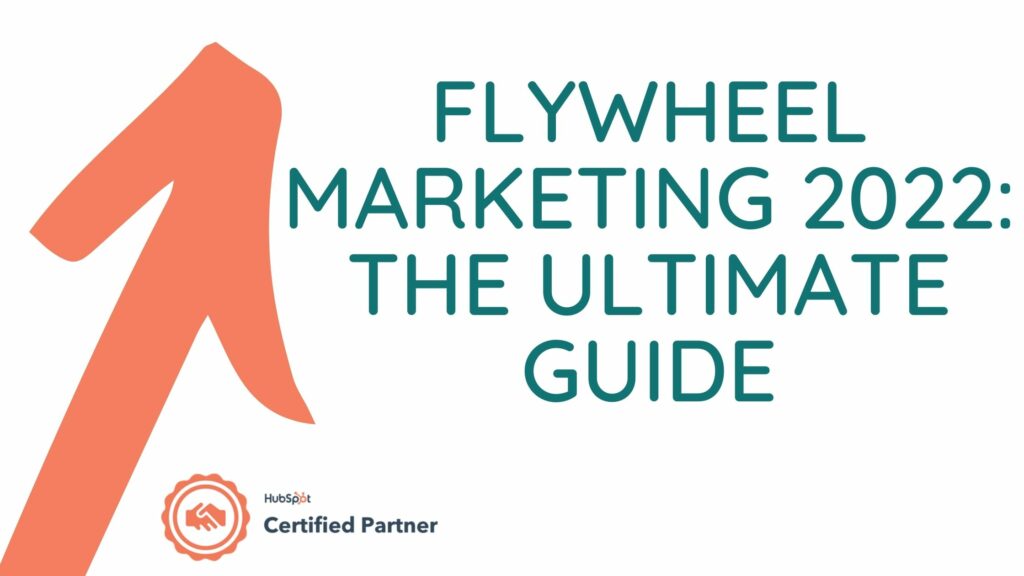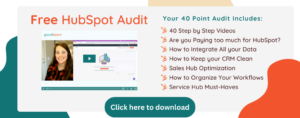HubSpot Flywheel Marketing 2022: The Ultimate Guide

Written by
Good Team
Created on
March 30, 2022
HubSpot Flywheel Marketing is the marketing model of 2022 and the future, here’s why…
Whether you’re new to marketing or have been around the block a few times, you know the goal of any business is to acquire more customers. And the way to go about doing this is by setting up some kind of system to see them through the process. Enter Flywheel Marketing.
Over the years, the most popular way of tracking where people are on their journey, from potential buyer to loyal customer, has been to use a funnel.
Whether that be through a marketing funnel, a sales funnel, or something else.
While this linear approach has worked for a number of years. The problem is, that once customers invest, they leave, never to be seen again. Then the process starts over with a brand new potential customer.
For businesses to get the most out of their marketing strategies, marketers are shifting their focus from a linear funnel that pushes customers through, to a circular model that keeps customers at the center.
Starting over from a cold lead is much more difficult than keeping an existing customer. The chance of converting an existing customer is around 60 percent while converting a new customer is around 5 percent.
So, the best way to keep more existing customers, rather than starting over, is to adopt this new marketing model- the Flywheel.
Flywheel vs. Sales Funnel
Sales Funnel
The sales funnel is the buyer’s journey from top to bottom that a person needs to take in order to become a customer.
In the funnel, there are four stages that a customer’s mindset must go through to make that journey that include awareness, interest, decision, and action.
The Four Stages of the Funnel:
Awareness: When a person becomes aware of your business and what you have to offer. This stage is where most marketers focus the bulk of their efforts. They think, the more people know about the company, the more customers they will get. Picture a sign with flashing lights, desperately trying to get your attention.
Interest: When a person is interested in your product, they begin to do the research, comparing prices and ratings.
Decision: When a customer is in the decision stage, they are ready to buy. They may have added to the cart your website and are considering a couple of options carefully. This is when offers like free shipping, or 20% off makes the most impact.
Action: When a customer buys your product, becomes a member, makes the call, books the appointment, etc.
So, that’s the sales funnel. Now let me tell you why we can do better.
Why the Sales Funnel is Outdated
The sales funnel focuses on getting people’s attention.
Most marketers who use this model will spend most of their money at the top of the funnel, trying to get anyone to notice them.
The thing is, there are more than 500,000 new businesses every month, so it’s becoming more and more difficult to stand out from the crowd.
So what do you do when you’re struggling to get the attention of the masses because of competition?
Instead of focusing on trying to grab the attention of people who have never heard of your company, why not focus on engaging and retaining the customers you already have?
Which is exactly the main focus of the Flywheel.
What is Flywheel Marketing
The Flywheel is a modern marketing model that focuses your marketing efforts on your customers and growing your company.
Instead of linear stages like the buyer’s funnel, it’s a circular model with three stages and the customer at the center.
Let’s talk about the three stages.
Attract:
The first stage in Flywheel Marketing is the attract stage. It focuses on getting the attention of new potential customers and drawing them in.
This is a large part of the inbound marketing strategy- creating content that appeals to qualified visitors by answering common questions and pain points. This method is effective because you are already appealing to an audience that might be interested in your product or service, rather than the general audience.
To attract new potential customers:
- Know who you want to target (your dream customers) by creating a Buyer’s Persona– What questions do they have? What problems do they need to solve?
- Create content that answers those questions and solves those problems
- Promote your content on social media and your website
Your goal is to attract your perfect type of customer to your site by giving them valuable information through your content.
Engage:
After your dream customers have fallen in love with your content, it’s time for you to engage them by personalizing their experience.
Engage potential customers by making connections with the visitors of your website and turning them into leads. You can do this by offering content that goes more in-depth into their pain points or connecting through social media or email marketing.
Engaging with new and existing customers builds relationships and loyalty, they are more likely to come to you with future purchases.
Delight:
By now, your potential customer has decided to convert into an existing customer. Now it’s time to delight them by continuing to engage with them.
You can do this by having incredible customer service and offering content through email marketing that will help them use your product.
By delighting your customers, you turn them into loyal customers who will tell their friends and family about your amazing products.
How Flywheel Marketing is Different
The 3 stages- attract, engage, and delight might sound similar to the funnel but what really makes the Flywheel unique, is the customer.
Instead of the customer making their way through from top to bottom, they are at the center of it all with no beginning or end.
The Flywheel puts the customers in the middle of the model because they are the most important piece to the puzzle.
It’s different because instead of trying to get as many people as possible to buy your product, this marketing method focuses on providing value to the customer.
The Customer
If you ask any business owner what has changed the most over the years, I bet their answer would be, “the customers”. Customers today need large amounts of information and social proof to buy a product.
They are more skeptical and have higher expectations than ever. And one of those exceptions is being cared for rather than sold to.
When companies focus on profits and sacrifice their morals or mislead you to get a sale, they make sure the world knows about it. Customers have the power to make or break you as a business.
So, why not take that influence and run with it, by meeting even the highest customer expectations.
5 Ways the Flywheel Can Improve your Marketing Strategy
One: the Flywheel Utilizes a Modern Mindset for a Modern Customer
If you’re hooked on the traditional funnel, you’re probably more focused on the traditional marketing mindset. The old way of marketing involved getting your name out there as much as possible. This is why banner ads, billboards, and commercials all rose to prominence in the first place.
The problem is that these strategies work less and less often than they did in the past. People don’t see an ad and think, “Oh, I need that product.” Instead, they ignore it and move on. Instead, modern customers are more proactive; they realize they need something, then search the internet for it. Through Google searches, friends’ recommendations, and customer reviews, they find the products themselves. The Harvard Business Review even found that 57% of buyers decide on business-to-business purchases before they even contact the seller.
The flywheel counteracts this problem by shifting the focus to inbound leads and creating a fulfilling customer experience. This way, your marketing strategy has the dual effect of marketing your product to the right people, then making sure they’ll come back for more and tell their friends.
Two: the Flywheel Allows for More Synergy Between Stages
While traditional funnels isolate each stage in the sales process, a well-executed flywheel allows these stages to flow into each other. This lowers the chances of miscommunication or customer confusion.
Though you might need to put more effort into ensuring your teams communicate effectively, the customer will appreciate the consistency and easy transition. Moreover, your sales, marketing, and customer support teams will have an easier time communicating once you set up the proper channels.
Three: the Flywheel Increases Efficiency
The reason the funnel is called a funnel is that it’s assumed the majority of leads won’t make it to the funnel’s end. While it casts a wide net, it’s built to account for leakage. The flywheel—on the other hand—narrows the prospective leads at the beginning, taking a quality-over-quantity approach.
Instead of wasting time trying to appeal to everyone, the flywheel allows you to shift your focus to a more narrow audience. Though this might seem counter-intuitive, it allows you to invest more time and energy into retaining each customer. Now, you can spread the resources previously devoted to marketing and spread them out across more departments.
Four: the Flywheel Allows Customers to Help the Sales Process
In the modern marketing landscape, word-of-mouth is quintessential. While the traditional sales funnel doesn’t account for how customers could help your growth, the flywheel considers them a key aspect. That’s why the flywheel is built on ensuring a phenomenal customer experience. While advertising may give your flywheel the initial push it needs, the customers are the ones who keep it spinning.
Once a customer trusts your company and your product or service, they’ll keep coming back. They’ll become more likely to tell their friends or talk about your product on social media. This loyalty is a key factor in the sustainable growth the flywheel can provide. While potential leads may not listen to you, they’ll listen to their friends and family.
Five: the Flywheel Benefits the Customer
If you care about your customers—and you should—then you’ll be happy to know that everyone wins with the flywheel. Not only do you reduce the number of annoying ads your leads need to see, but you also help customers find what they need, create useful resources, and utilize various programs and offers they’ll find beneficial.
The goal of these programs isn’t just to generate leads but to help your customers feel appreciated.
Does Flywheel Marketing Work for Every Business?
Whether you are online or a brick-and-mortar business, this model will benefit you. When your marketing efforts attract, engage, and delight your customers, your Flywheel begins to spin, gaining traction.
The more people that are loyal to your company and share their experiences with people around them, the more you build momentum.
How to Switch?
Switching from the Funnel to the Flywheel is less complicated and more cost-effective than you might think. It’s more like a shift than a switch. The good news is that you most likely, already have everything that you need in place.
One way to switch is by reallocating spending from the top of the funnel to the delight stage.
For example, instead of spending time on broad content topics, you could create articles on topics that would help your existing customers instead, making them feel like insiders.
Investing in Flywheel as your marketing model will help you stand out from the crowd!
Making the switch doesn’t have to be difficult and if you need a hand with this transition, goodteam.agency is here to help! Click here to schedule a free call.
Help Me HubSpot
Get Your Free DIY 40-Point HubSpot Audit with Videos!


